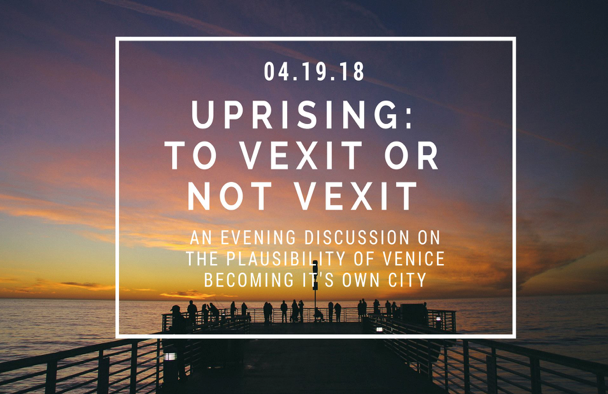CommentsWHEN ENOUGH IS ENOUGH--On April 19, the Outreach Committee of the Venice Neighborhood Council held a town hall meeting to discuss the viability of a movement known as Vexit, the de-annexation of Venice from the City of Los Angeles.
The de-annexation of a city can be similar to a high stakes divorce with each party delving into assets and liabilities. What’s at stake for the City of Los Angeles and is it possible for Venice to be self-sustaining? Back in 2000, the passage of the Cortese-Knox-Hertzberg Local Government Reorganization Act of 2000 established procedures for local government changes of organization, including annexations to a city or special district.
The president of the Venice Stakeholders Association favors amending this process. Mark Ryavec has appealed to the board of the Venice Neighborhood Council to draft a motion that would remove the Los Angeles City Council’s veto and the requirement that Vexit would be submitted to the voters of Los Angeles.
Ryavec says the Neighborhood Council’s Jim Murez questioned at the recent Town Hall meeting whether the motion to ease the de-annexation process might open the door to San Pedro. Because a de-annexation by the city to the south would include the valuable Port of Los Angeles, the City and its Council would be unlikely to sponsor or support the requisite legislation in Sacramento, hampering the Venice effort.
In response, Ryavec is appealing to the Neighborhood Council to submit a formal request to the City of Los Angeles to “sponsor and amend the Cortese-Knox-Hertzberg Local Government Reorganization Act of 2000 to void the City of Los Angeles’ right to cause the termination of a detachment request pending before a local area formation commission,” noting the absence of a port or airport within the borders of Venice.
Venice was an independent city until 1926 when residents voted to annex the city to the City of Los Angeles. Ryavec says the current residents of Venice should have the option to reverse that decision without the “burden of it being rejected by other residents living in the rest of Los Angeles” and cites the success of other cities that enjoy increased responsiveness with more localized governments such as Culver City, Santa Monica, and West Hollywood.
In addition, Ryavec proposes that the VNC raise funds to retain an accounting or economic forecasting firm to analyze all tax revenue and fees collected from Venice. He adds that “”the VSA is open to providing the responses from the interrogatories from the public nuisance lawsuit that outline income derived from filming and special events at Venice Beach Recreation Area, which should be considered in a study of prospective income of the City of Venice.”
With a median property value of over $1.8 million, Venice is included among the top 10 average property values in Los Angeles County and Abbott Kinney retail brings in sales tax. As an independent city, Venice would get to keep a much larger share of sales tax revenue.
On the cost side, Venice would also need to replace certain services that it currently received from the city. Most cities of similar size subcontract services such as police and fire departments with the city or county, which could be at high cost. Additional services that would need to be overtaken include road and sidewalk maintenance,as well as sanitation services and parking enforcement. An independent school district would need to reach an agreement with the county.
As a smaller municipality, Venice might end up paying a higher cost for services than a city the size of Los Angeles. However, the upside would include more local control.
With careful consideration of data, Venice may decide to de-annex from the city of Los Angeles but the process would be more likely if left in the hands of Venice residents than if left to the voters of Los Angeles City.
We’ll keep you posted about the Vexit status.
(Beth Cone Kramer is a professional writer living in the Los Angeles area. She covers Resistance Watch and other major issues for CityWatch.)
-cw














